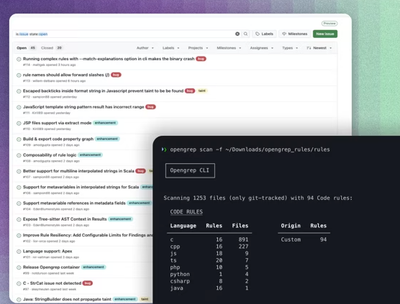
Research
Security News
Lazarus Strikes npm Again with New Wave of Malicious Packages
The Socket Research Team has discovered six new malicious npm packages linked to North Korea’s Lazarus Group, designed to steal credentials and deploy backdoors.
socket.io
Advanced tools
The socket.io npm package enables real-time, bidirectional and event-based communication between web clients and servers. It is primarily used to build real-time web applications and has features like broadcasting to multiple sockets, storing data associated with each client, and asynchronous I/O.
Real-time bidirectional event-based communication
This feature allows the server to establish a WebSocket connection with the client for real-time communication. The server listens for events like 'connection', 'chat message', and 'disconnect' to react accordingly.
const io = require('socket.io')(3000);
io.on('connection', (socket) => {
console.log('a user connected');
socket.on('chat message', (msg) => {
io.emit('chat message', msg);
});
socket.on('disconnect', () => {
console.log('user disconnected');
});
});Broadcasting
Broadcasting allows a server to send a message to all connected clients except for the one that triggered the message. This is useful for notifying all users about the actions of one.
io.on('connection', (socket) => {
socket.broadcast.emit('user connected', 'A new user has joined the chat');
});Namespaces and Rooms
Socket.IO allows for the creation of Namespaces and Rooms which can be used to divide the clients into different groups for targeted broadcasting and communication.
const chat = io.of('/chat').on('connection', (socket) => {
socket.join('some room');
chat.to('some room').emit('some event');
});The 'ws' package is a simple WebSocket library for Node.js. Unlike socket.io, it does not provide high-level features like broadcasting to multiple sockets or automatic reconnection.
Engine.io is the low-level engine that powers socket.io. It provides the bare WebSocket-like API and is responsible for handling the transport logistics. It is less feature-rich compared to socket.io.
SockJS is a JavaScript library that provides a WebSocket-like object. It is similar to socket.io in that it offers a fallback mechanism for environments where WebSockets are not supported.
Faye is a set of tools for simple publish-subscribe messaging between web clients. It's more focused on the pub/sub paradigm and lacks some of the real-time communication features that socket.io offers.
The Socket.IO server provides seamless support for a variety of transports intended for realtime communication.
crypto module support (make sure you have OpenSSL
headers when installing Node to get it)To run the demo, execute the following:
git clone git://github.com/LearnBoost/Socket.IO-node.git socket.io
cd socket.io/example/
sudo node server.js
and point your browser to http://localhost:8080. In addition to 8080, if the transport flashsocket is enabled, a server will be initialized to listen for requests on port 843.
Socket.IO is designed not to take over an entire port or Node http.Server instance. This means that if you choose to have your HTTP server listen on port 80, socket.io can intercept requests directed to it, and normal requests will still be served.
By default, the server will intercept requests that contain socket.io in the path / resource part of the URI. You can change this as shown in the available options below.
On the server:
var http = require('http'),
io = require('./path/to/socket.io'),
server = http.createServer(function(req, res){
// your normal server code
res.writeHead(200, {'Content-Type': 'text/html'});
res.end('<h1>Hello world</h1>');
});
server.listen(80);
// socket.io, I choose you
var socket = io.listen(server);
socket.on('connection', function(client){
// new client is here!
client.on('message', function(){ … })
client.on('disconnect', function(){ … })
});
On the client:
<script src="/socket.io/socket.io.js"></script>
<script>
var socket = new io.Socket();
socket.connect();
socket.on('connect', function(){ … })
socket.on('message', function(){ … })
socket.on('disconnect', function(){ … })
</script>
The client-side files are served automatically by Socket.IO-node.
io.listen(<http.Server>, [options])
Returns: a Listener instance
Public Properties:
server
An instance of process.http.Server.
options
The passed-in options, combined with the defaults.
clients
An object of clients, indexed by session ID.
Methods:
addListener(event, λ)
Adds a listener for the specified event. Optionally, you can pass it as an option to io.listen, prefixed by on. For example: onClientConnect: function(){}
removeListener(event, λ)
Removes a listener from the listener array for the specified event.
broadcast(message, [except])
Broadcasts a message to all clients. Optionally, you can pass a single session ID or array of session IDs to avoid broadcasting to, as the second argument.
Options:
resource
socket.io
The resource is what allows the socket.io server to identify incoming connections from socket.io clients. Make sure they're in sync.
flashPolicyServer
true
Create a Flash Policy file server on port 843 (this is restricted port and you will need to have root permission). If you disable the FlashPolicy file server, Socket.IO will automatically fall back to serving the policy file inline.
transports
['websocket', 'flashsocket', 'htmlfile', 'xhr-multipart', 'xhr-polling',
'jsonp-polling']
A list of the accepted transports.
transportOptions
An object of options to pass to each transport. For example { websocket: { closeTimeout: 8000 }}
log
ƒ(){ sys.log }
The logging function. Defaults to outputting to stdout through sys.log
Events:
clientConnect(client)
Fired when a client is connected. Receives the Client instance as parameter.
clientMessage(message, client)
Fired when a message from a client is received. Receives the message and Client instance as parameters.
clientDisconnect(client)
Fired when a client is disconnected. Receives the Client instance as a parameter.
Important note: this in the event listener refers to the Listener instance.
Client(listener, req, res)
Public Properties:
listener
The Listener instance to which this client belongs.
connected
Whether the client is connected.
connections
Number of times the client has connected.
Methods:
send(message)
Sends a message to the client.
broadcast(message)
Sends a message to all other clients. Equivalent to Listener::broadcast(message, client.sessionId).
One of the design goals is that you should be able to implement whatever protocol you desire without Socket.IO getting in the way. Socket.IO has a minimal, unobtrusive protocol layer, consisting of two parts:
Connection handshake
This is required to simulate a full duplex socket with transports such as XHR Polling or Server-sent Events (which is a "one-way socket"). The basic idea is that the first message received from the server will be a JSON object that contains a session ID used for further communications exchanged between the client and server.
The concept of session also naturally benefits a full-duplex WebSocket, in the event of an accidental disconnection and a quick reconnection. Messages that the server intends to deliver to the client are cached temporarily until reconnection.
The implementation of reconnection logic (potentially with retries) is left for the user. By default, transports that are keep-alive or open all the time (like WebSocket) have a timeout of 0 if a disconnection is detected.
Message batching
Messages are buffered in order to optimize resources. In the event of the server trying to send multiple messages while a client is temporarily disconnected (eg: xhr polling), the messages are stacked and then encoded in a lightweight way, and sent to the client whenever it becomes available.
Despite this extra layer, the messages are delivered unaltered to the various event listeners. You can JSON.stringify() objects, send XML, or even plain text.
Guillermo Rauch <guillermo@learnboost.com> (Guille)
Arnout Kazemier (3rd-Eden)
(The MIT License)
Copyright (c) 2010 LearnBoost <dev@learnboost.com>
Permission is hereby granted, free of charge, to any person obtaining a copy of this software and associated documentation files (the 'Software'), to deal in the Software without restriction, including without limitation the rights to use, copy, modify, merge, publish, distribute, sublicense, and/or sell copies of the Software, and to permit persons to whom the Software is furnished to do so, subject to the following conditions:
The above copyright notice and this permission notice shall be included in all copies or substantial portions of the Software.
THE SOFTWARE IS PROVIDED 'AS IS', WITHOUT WARRANTY OF ANY KIND, EXPRESS OR IMPLIED, INCLUDING BUT NOT LIMITED TO THE WARRANTIES OF MERCHANTABILITY, FITNESS FOR A PARTICULAR PURPOSE AND NONINFRINGEMENT. IN NO EVENT SHALL THE AUTHORS OR COPYRIGHT HOLDERS BE LIABLE FOR ANY CLAIM, DAMAGES OR OTHER LIABILITY, WHETHER IN AN ACTION OF CONTRACT, TORT OR OTHERWISE, ARISING FROM, OUT OF OR IN CONNECTION WITH THE SOFTWARE OR THE USE OR OTHER DEALINGS IN THE SOFTWARE.
FAQs
node.js realtime framework server
We found that socket.io demonstrated a healthy version release cadence and project activity because the last version was released less than a year ago. It has 2 open source maintainers collaborating on the project.
Did you know?

Socket for GitHub automatically highlights issues in each pull request and monitors the health of all your open source dependencies. Discover the contents of your packages and block harmful activity before you install or update your dependencies.

Research
Security News
The Socket Research Team has discovered six new malicious npm packages linked to North Korea’s Lazarus Group, designed to steal credentials and deploy backdoors.

Security News
Socket CEO Feross Aboukhadijeh discusses the open web, open source security, and how Socket tackles software supply chain attacks on The Pair Program podcast.

Security News
Opengrep continues building momentum with the alpha release of its Playground tool, demonstrating the project's rapid evolution just two months after its initial launch.